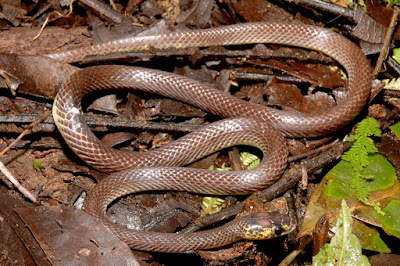 |
[upper] Stegonotus iridis
[lower] Stegonotus derooijae
(a) Stegonotus cucullatus, (c) Stegonotus modestus, (e) Stegonotus parvus
Photos from Christopher C. Austin (a, c, e). @Sara_and_Snakes
|
ABSTRACT
The island of New Guinea has been identified as biologically megadiverse but many taxa are still poorly known. This is especially the case for many of the island’s snakes, which by their very nature can be difficult to collect and study. Here we examine the phylogenetic and phylogeographic structure of a poorly studied snake genus, Stegonotus, focusing on the species of New Guinea; until now, Stegonotus has never been examined using modern phylogenetic methods. Using molecular data from 49 individuals representing eight of the ten described species, and including all New Guinea taxa, we estimate a multilocus phylogeny and examine population structure to help identify undescribed taxa. We use morphological data from the corresponding museum vouchered specimens (where available) and also examine additional specimens for taxa not included in the molecular data set to determine morphological differences among putative taxa. We find molecular evidence for four new species of Stegonotus, both morphologically obvious and cryptic, and describe them herein. The recognition of these four species indicates that Stegonotus diversity has been previously underestimated and also suggests that there are likely additional undescribed taxa within the genus. These four taxa increase the number of described species by 40% and further confirm New Guinea as the centre of diversity for the genus.
KEYWORDS: Australasia, colubrine, Indonesia, integrative taxonomy, phylogenetics
 |
| Stegonotus iridis sp. nov. SAMA R70466
Photos from Stephen J. Richards.
|
 |
| Photographs of holotype Stegonotus iridis sp. nov. MZB.Ophi.3306; dorsal of body, ventral of body.
Photos from Stephen J. Richards.
|
Stegonotus iridis sp. nov.
Etymology: The species epithet is a noun in apposition and taken from the Latin word for rainbow. It
refers to the high level of iridescence shown both dorsally and ventrally by this species.
Natural history and distribution: Currently known only from the Raja Ampat islands of Batanta, Salawati and Waigeo in
eastern Indonesia where all of the animals encountered were active on the forest floor in
moderately to heavily disturbed lowland (< 100 m asl) rainforest at night. The pale
colour of this species made them extremely conspicuous against the dark forest floor.
 |
| Stegonotus derooijae sp. nov. MZB.Ophi.3288
Photos from Stephen J. Richards.
|
Stegonotus derooijae sp. nov.
Etymology: The species epithet is a noun in the genitive case and is a patronym in honour of Dr
Nelly De Rooij, who described many taxa from New Guinea and Indonesia, including
Stegonotus florensis.
Natural history and distribution: Currently known only from the Raja Ampat islands of Batanta, Salawati and Waigeo in
eastern Indonesia. This small, slender species was active on the forest floor in moderately
to heavily disturbed lowland (< 100 m above sea level) rainforest at night. At each
site it occurred in sympatry with S. iridis sp. nov., described above.
Stegonotus melanolabiatus sp. nov.
Etymology: The species epithet comes from the Greek melano meaning black or dark and the Latin
word labia for lips. The name refers to the dark coloration of the labial scales of this
species.
Natural history and distribution: No information is known about the natural history of S. melanolabiatus. Stegonotus
melanolabiatus sp. nov. is found south of the central mountain ranges (Figure 3) in
Southern Highlands and Chimbu Provinces of Papua New Guinea. It may also occur in
other provinces and regions south of the central cordillera across New Guinea.
Stegonotus admiraltiensis sp. nov.
Etymology: The species epithet refers to the Admiralty Islands where this species is found, an
archipelago of 18 islands to the north of New Guinea, comprising Manus Province,
Papua New Guinea.
Natural history and distribution: As with all New Guinea Stegonotus, S. admiraltiensis sp. nov. is nocturnal. All four specimens
were collected at night as they were moving on the forest floor on the leaf litter. Typical for
Stegonotus, once picked up S. admiraltiensis sp. nov. rapidly attempted to bite the collector’s
hand and writhed violently in a side-to-side motion. Nothing more is known about the
natural history or ecology of S. admiraltiensis sp. nov. Stegonotus admiraltiensis sp. nov. is
found on the islands of Rambutyo and Los Negros in Manus Province of Papua New Guinea.
Based on descriptions of similar specimens from Manus (McDowell 1972) and recent
collections there by SJR that will be registered in the near future (Richards and Aplin
2015), we conclude that S. admiraltiensis sp. nov. is also found on Manus Island proper
and that all specimens of Stegonotus from the Admiralty Islands are S. admiraltiensis sp. nov.
Sara Ruane, Stephen J. Richards, John D. McVay, Burhan Tjaturadi, Keliopas Krey and Christopher C. Austin. 2017. Cryptic and Non-Cryptic Diversity in New Guinea Ground Snakes of the Genus Stegonotus Duméril, Bibron and Duméril, 1854: A Description of Four New Species (Squamata: Colubridae). Journal of Natural History. DOI: 10.1080/00222933.2017.1391959
ResearchGate.net/publication/321315773_New_Guinea_ground_snakes_of_the_genus_Stegonotus
sararuane.wordpress.com/about/publications
Naming a New Guinea Snake Species, Honoring a Legacy http://lsuscienceblog.squarespace.com/blog/2017/12/5/naming-a-new-guinea-snake-species-honoring-a-legacy
twitter.com/@Sara_and_Snakes/status/935534748381974528
sararuane.wordpress.com/about/publications
Naming a New Guinea Snake Species, Honoring a Legacy http://lsuscienceblog.squarespace.com/blog/2017/12/5/naming-a-new-guinea-snake-species-honoring-a-legacy
twitter.com/@Sara_and_Snakes/status/935534748381974528




